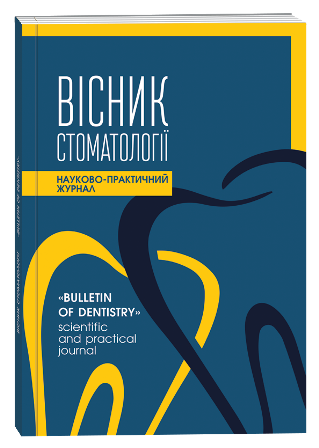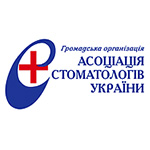STUDY OF THE STATE OF THE “ANTIMICROBIAL PROTECTION – BACTERIAL CONTAMINATION” SYSTEM IN THE ORAL FLUID OF PATIENTS WITH PERI-IMPLANTITIES AGAINST THE BACKGROUND OF THE TREATMENT AND PREVENTION COMPLEX
DOI:
https://doi.org/10.35220/2078-8916-2024-54-4.10Keywords:
implants, biochemical markers, treatment and prevention complex, oral fluid, patientsAbstract
Peri-implantitis is among the most common complications of dental implantation and can lead to implant loss and a significant deterioration in patients’ quality of life. Comorbid conditions, such as periodontitis and atherosclerosis, significantly complicate the clinical course of peri-implantitis, intensify inflammatory processes, and may accelerate bone resorption. The state of the “antimicrobial protection – bacterial contamination” system in the oral fluid is one of the key indicators of the effectiveness of peri-implantitis treatment and prevention, as a high level of urease indicates an increased bacterial load, whereas a decrease in lysozyme activity suggests a weakening of local antimicrobial mechanisms. Purpose of the study. To evaluate the effect of a therapeutic drug complex on the state of the “antimicrobial protection – bacterial contamination” system in the oral fluid of patients with peri-implantitis. Materials and methods. The study involved patients with peri-implantitis aged 25 to 55 years. They were divided into groups: somatically healthy individuals, patients who received only basic therapy, and patients who additionally used a treatment and prophylactic complex that included drugs with antioxidant and anti-inflammatory effects, agents to restore microbiocenosis and microcirculation, and drugs with an osteotropic mechanism of action. The degree of dysbiosis in the oral fluid was determined by the ratio of the relative activities of urease to lysozyme. Statistical analysis was performed using Student’s t-test at a significance level of p<0.01. Research results. In patients with peri-implantitis complicated by periodontitis and atherosclerosis, a significant increase in the degree of dysbiosis was found prior to treatment compared with control values. Basic therapy (comparison group) led to a temporary decrease in dysbiosis only during the first month of treatment; subsequently, the indicator exceeded the baseline level at 3 to 6 months. In the main group of patients who additionally received the treatment-prophylactic complex, there was a marked and stable decrease in the degree of dysbiosis: by 6 months, it approached values close to normal, and a positive trend persisted throughout the year, indicating the effectiveness and prolonged action of the proposed complex. Conclusions. The combined use of a treatment-prophylactic complex with basic therapy effectively normalizes the biochemical markers of local nonspecific reactivity and the level of microbial colonization in patients with peri-implantitis against the background of comorbid conditions. This finding supports the feasibility of using such an approach in clinical practice to improve treatment outcomes and prevent complications.
References
Halstenbach T., Nelson K., Iglhaut G., Schilling O., Fretwurst T. Impact of peri-implantitis on the proteome biology of crevicular fluid: A pilot study. J Periodontol. 2023. №94(7). Р. 835-847. DOI: 10.1002/JPER.22-0461.
Zhuang L.F., Watt R.M., Mattheos N., Si M.S., Lai H.C., Lang N.P. Periodontal and peri-implant microbiota in patients with healthy and inflamed periodontal and peri-implant tissues. Clin Oral Implants Res. 2016. №27(1). Р. 13-21. DOI: 10.1111/clr.12508.
Canullo L., Radovanović S., Delibasic B., Blaya J.A., Penarrocha D., Rakic M. The predictive value of microbiological findings on teeth, internal and external implant portions in clinical decision making. Clin Oral Implants Res. 2017. №28(5). Р. 512-519. DOI: 10.1111/ clr.12828.
Marcantonio C., Nicoli L.G., Marcantonio Junior E., Zandim-Barcelos D.L. Prevalence and Possible Risk Factors of Peri-implantitis: A Concept Review. J Contemp Dent Pract. 2015. №16(9). Р. 750-7. DOI: 10.5005/jp-journals-10024-1752.
Canullo L., Peñarrocha M., Monje A., Catena A., Wang H.L., Peñarrocha D. Association Between Clinical and Microbiologic Cluster Profiles and Peri-implantitis. Int J Oral Maxillofac Implants. 2017. №32(5). Р. 1054-1064. DOI: 10.11607/jomi.6043.
Lumbikananda S., Srithanyarat S.S., Mattheos N., Osathanon T. Oral Fluid Biomarkers for Peri-Implantitis: A Scoping Review. Int Dent J. 2024. №74(3). Р. 387-402. DOI: 10.1016/j.identj.2023.11.005.
Методи дослідження стану кишечнику та кісток у лабораторних щурів : довідник / О. А. Макаренко та ін. Одеса : Одес. нац. ун-т ім. І. І. Мечникова, 2022. 81 с.
Рогач І. М., Керецман А. О., Сіткар А. Д. Правильно вибраний метод статистичного аналізу – шлях до якісної інтерпретації даних медичних досліджень. Науковий вісник Ужгородського університету. 2017. Вип. 2. С. 124-28.









